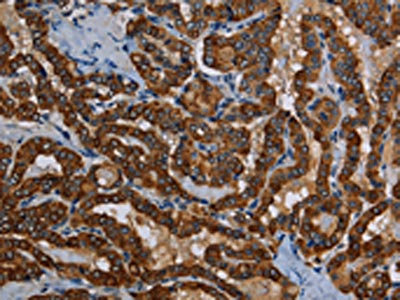
The image on the left is immunohistochemistry of paraffin-embedded Human thyroid cancer tissue using CSB-PA787705(PIDD1 Antibody) at dilution 1/50, on the right is treated with fusion protein. (Original magnification: x200)
PIDD1 Antibody
CSB-PA787705
ApplicationsELISA, ImmunoHistoChemistry
Product group Antibodies
ReactivityHuman
TargetPIDD1
Overview
- SupplierCusabio
- Product NamePIDD1 Antibody
- Delivery Days Customer20
- ApplicationsELISA, ImmunoHistoChemistry
- CertificationResearch Use Only
- ClonalityPolyclonal
- ConjugateUnconjugated
- Gene ID55367
- Target namePIDD1
- Target descriptionp53-induced death domain protein 1
- Target synonymsLRDD, MRT75, PIDD, p53-induced death domain-containing protein 1, leucine-rich repeat and death domain-containing protein, leucine-rich repeats and death domain containing, p53-induced protein with a death domain
- HostRabbit
- IsotypeIgG
- Protein IDQ9HB75
- Protein Namep53-induced death domain-containing protein 1
- Scientific DescriptionThe protein encoded by this gene contains a leucine-rich repeat and a death domain. This protein has been shown to interact with other death domain proteins, such as Fas (TNFRSF6)-associated via death domain (FADD) and MAP-kinase activating death domain-containing protein (MADD), and thus may function as an adaptor protein in cell death-related signaling processes. The expression of the mouse counterpart of this gene has been found to be positively regulated by the tumor suppressor p53 and to induce cell apoptosis in response to DNA damage, which suggests a role for this gene as an effector of p53-dependent apoptosis.
- ReactivityHuman
- Storage Instruction-20°C or -80°C
- UNSPSC41116161






